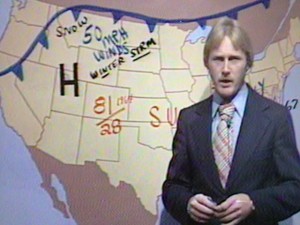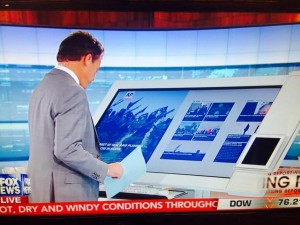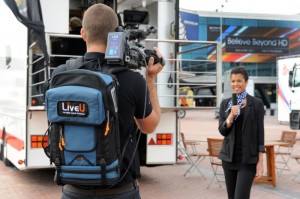Blog
Your Next Live Shot Could Be A Selfie!
December 12, 2014
Keeping up with the latest technology is a big part of my talent coaching. Technology is changing the way we report the news and how we relate to the audience.

These graphics were state-of-the-art at WCHS-TV in 1978. Seriously.
Weather: Old school weather graphics were the only game in town. Back in the day, you needed the TV weather person to check the currents, the almanac and tell you the forecast. Today, viewers can get endless amounts of weather data on their mobile devices. What they need is an expert — who is also a friend — to deliver a future-driven forecast and explain how the weather will affect their lives. This means weather presenters must re-think the balance of time they spend pointing to the graphics and relating to the audience.
Anchors: Most TV stations now have “magic wall” technology that enables news anchors to explain more details of a top story, using maps or charts. By the time the news comes on, viewers may already be aware of the day’s top stories through social media. News anchors must embrace the role of curating that information, and digging a little deeper for what it means to the audience. This is much more complicated than just reading a script on a teleprompter. In fact, the anchor may turn completely away from the prompter, facing the screen to manipulate the graphics. Viewers can relate because they do the same thing when they are operating their touchscreen tablets and phones.

Some TV news consultants point to Shep Smith and the Fox News Deck as the anchor of the future. Are you ready?
Reporters: In the field, one of my former students, Natalie Brunell at KESQ in Palm Springs, did an election night live shot on her iPad. Portable transmitters like Dejero or LiveU give you more options to go live. But it takes more than buying into the technology to make it an effective storytelling tool. It’s not enough to stand out in the storm looking miserable. Reporters must learn how to take us somewhere and show us something, and at the very least not look awkward during the all-too-common delay after they are introduced by the anchor.
Bottom line: I first started doing live shots when it required a four-person crew. It would be so cool to hit the road today with the flexibility to tell any story from anywhere, without worrying about stringing cable or putting up the mast. Applying the time-tested values of journalism in today’s high-tech environment is a big part of any news team’s power performance. Talent coaching can help you get there.

Promotional photo courtesy LiveU.
Tweet
Pleasure to meet you.
 Hi, I'm Terry Anzur. I've been a professional multimedia journalist for more than 30 years, anchoring and reporting everywhere from New York to Los Angeles to West Palm Beach. I've taught on-air skills to journalists of all levels, both through positions at the University of Southern California and Pepperdine University and through my own independent company.
Hi, I'm Terry Anzur. I've been a professional multimedia journalist for more than 30 years, anchoring and reporting everywhere from New York to Los Angeles to West Palm Beach. I've taught on-air skills to journalists of all levels, both through positions at the University of Southern California and Pepperdine University and through my own independent company.
If you're interested in talent coaching, whether on a personal or station-wide level, follow the "Media Coaching" links above for useful resources and detailed information on how I can help. Or just drop me a note to chat more about a customized package that can meet your needs for public relations or international journalism training.




